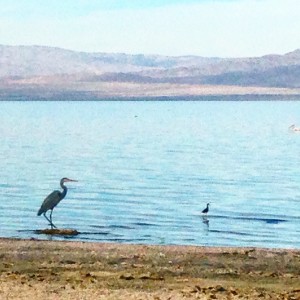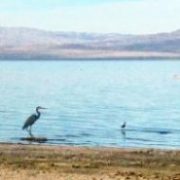
A 2015 file photo from the shores of the Salton Sea.
On Thursday, Nov. 17, California Department of Water Resources announced a grant for $14 million from the Wildlife Conservation Board to help fund habitat restoration at the Salton Sea. Good news for sure.
That funding will be earmarked for Phase One of the State’s Species Conservation Habitat project, covering the costs of constructing some 640 acres of new fish habitat on exposed playa that will in turn serve the needs of migratory birds. And, the habitat project—by covering playa—will protect human health. But there’s an added benefit to this funding. Ultimately, it means that the $80.5 million from Proposition 1 funds, which Governor Jerry Brown pledged to the Sea, will be freed up (at least $60 million of it) to build additional habitat at the Sea.
In a press release, California Secretary of Natural Resources John Laird said, “This new grant will help us build habitat that protects the bird population at the Salton Sea. We’re pushing forward with projects in our 10-year plan to protect wildlife and air quality as water flows to the sea decrease in coming years.”
This is indeed a positive step and one worth celebrating. While merely a piece of what must be a sustained effort on the part of the State to address restoration under its Salton Sea Management Program, it nevertheless is yet one more indication that the Salton Sea is not a forgotten body of water and that the State—though later than anyone would have liked—is now recognizing its responsibilities on the Sea and advancing projects.
In 2017, construction is expected to be underway on two critical projects, the Species Conservation Habitat mentioned above and the Red Hill Marina project, a 400-acre wetlands project, to be built on exposed playa, in particular in an area known to have emissive dust issues. In fact, earth work is now underway at Red Hill Marina.
It is time for these projects to begin work in earnest and for stakeholders to see projects underway. It is the lack of construction on restoration projects that leads to the kind of frustrations many stakeholders are voicing about what they consider delayed progress on the part of the State at the Sea. When in 2007 a $9 billion restoration project was selected as a preferred alternative without funding, it did seem like efforts at the Sea ground to a halt, save for the environmental mitigation efforts under the Quantification Settlement Agreement Joint Powers Authority, which have been a constant at the Sea. But now there is real movement toward restoration, which can work hand in hand with mitigation efforts as they relate to the QSA, to protect air quality and provide habitat.
Every step moves us closer to realizing a feasible restoration program, and so this is the kind of news that needs to be shared. It stands as actual evidence of progress at the Sea, progress that must be steady with an annual allotment of funding.
